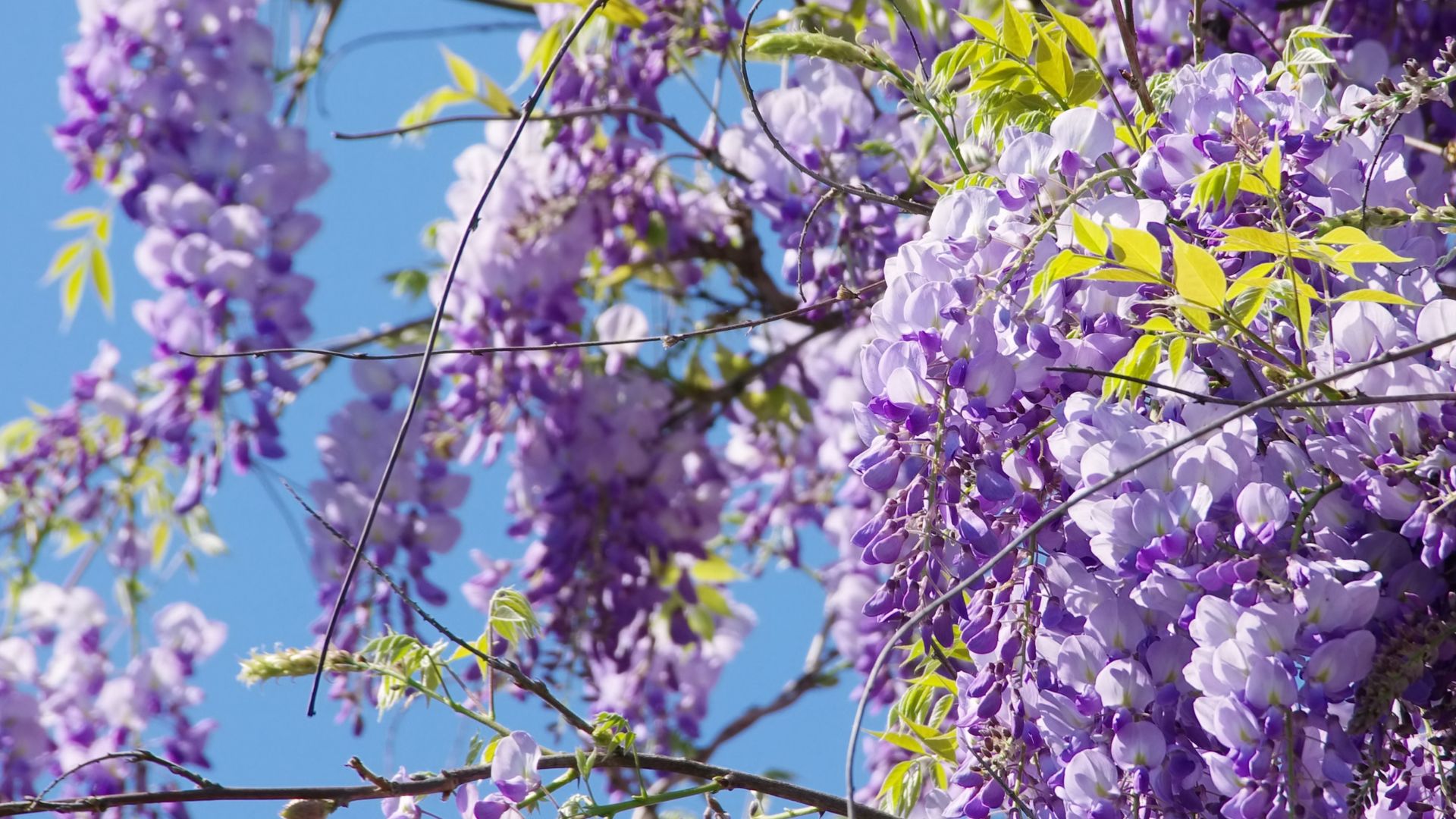Nature lovers alike find solace in the beauty of flowering vines that gracefully sprawl and climb, transforming ordinary spaces into vibrant, lush displays of color.
Let us discuss some of the fast-growing vine varieties, each adorned with exquisite blooms, and the specific zones where they thrive.
From the sun-kissed regions to the cooler climates, these vines bring joy to gardeners across diverse landscapes.
Top 17 Fast-Growing Flowering Vines List

Fast-Growing Flowering Vines
1). Bougainvillea (Zones 9-11)

One of the most iconic and versatile flowering vines is the Bougainvillea, known for its vibrant bracts that come in an array of hues, including magenta, purple, and orange. This fast-grower thrives in warm climates, typically in USDA hardiness zones 9 to 11. Bougainvillea’s adaptability to various soil types and its drought tolerance make it a favorite among gardeners in arid regions.
To ensure optimal growth, plant Bougainvillea in full sun and provide well-draining soil. Regular pruning promotes a bushier habit and enhances flowering. This tropical beauty not only adds aesthetic appeal but also attracts butterflies and hummingbirds, contributing to a lively garden ecosystem.
2). Clematis (Zones 4-11)
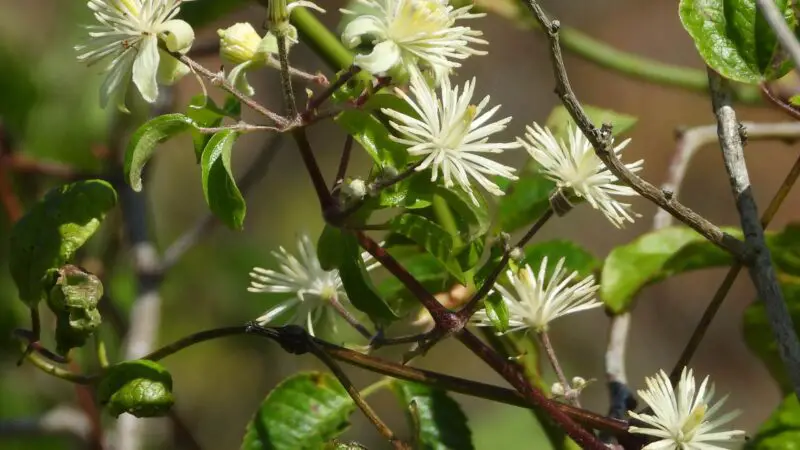
Clematis, a diverse genus of climbing vines, encompasses a wide range of species and cultivars, making it suitable for a broad spectrum of climates. With varieties that thrive in zones 4 to 11, Clematis is a go-to choice for many gardeners seeking a fast-growing and visually striking vine.
The large, star-shaped flowers of Clematis come in an array of colors, from the classic purples and blues to pinks, reds, and whites. Depending on the variety, Clematis can be planted in full sun or partial shade. Ensure adequate support for these climbers, as they can reach impressive heights when provided with the right conditions.
3). Honeysuckle (Zones 4-9)

The fragrant and charming Honeysuckle vine is a fast-growing favorite in zones 4 to 9. With its sweet-scented blossoms that attract bees and hummingbirds, this vine is a delightful addition to any garden. The trumpet-shaped flowers come in various colors, including shades of pink, yellow, and white.
Honeysuckle prefers full to partial sun and well-draining soil. Regular pruning helps maintain its shape and encourages more prolific blooming. The versatility of Honeysuckle makes it suitable for arbors, fences, and trellises, providing both beauty and functionality to outdoor spaces.
4). Morning Glory (Annual, All Zones)
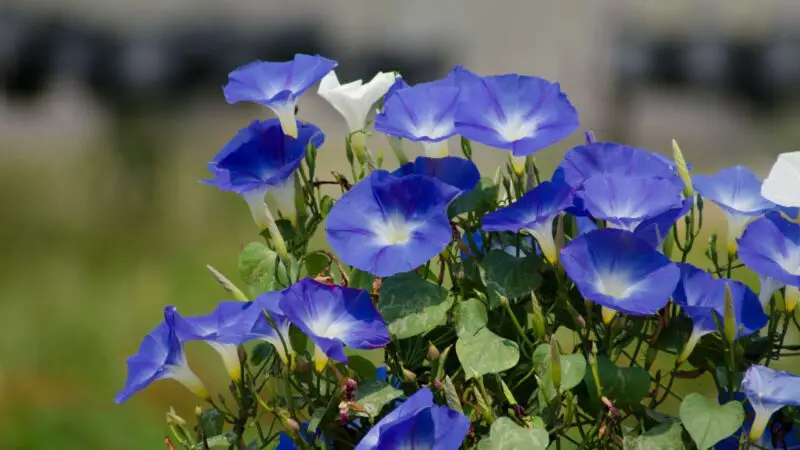
For gardeners seeking a fast-growing annual vine that covers fences and trellises with a burst of color, Morning Glory is an excellent choice. While technically an annual, Morning Glory self-seeds easily, creating a continuous display year after year. Its heart-shaped leaves and trumpet-shaped flowers in shades of blue, purple, pink, and white make it a popular addition to gardens across all zones.
Morning Glory thrives in full sun and well-drained soil. Since it’s an annual, it’s a great option for adding quick, seasonal impact to your garden. Be mindful of its exuberant growth and provide ample support for this climbing beauty.
5). Wisteria (Zones 4-9)
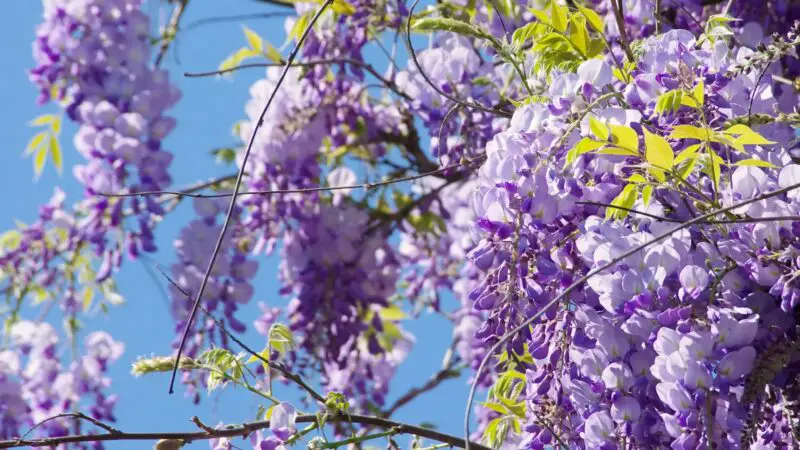
Fast-Growing Flowering Vines
Renowned for its cascading clusters of fragrant, pendulous flowers, Wisteria is a captivating vine that flourishes in zones 4 to 9. Its show-stopping lavender, blue, or white blossoms make it a standout feature in gardens and landscapes.
Plant Wisteria in full sun with well-draining soil, and provide a sturdy support structure, as these vines can become quite heavy. Pruning is essential to control its exuberant growth and encourage abundant flowering. Wisteria’s picturesque appearance and alluring fragrance make it a popular choice for pergolas and archways.
6). Passionflower (Zones 6-9)
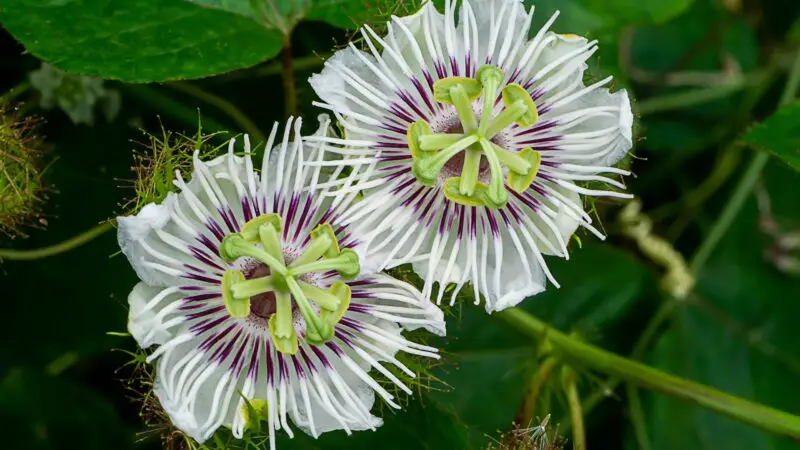
Passionflower, with its intricate and exotic blooms, is a fast-growing vine that flourishes in zones 6 to 9. Known for its unique, otherworldly appearance, the passionflower produces showy, fringed blossoms in shades of purple, blue, and white. Beyond its aesthetic appeal, this vine also attracts pollinators, making it a valuable addition to your garden ecosystem.
Plant passionflower in well-drained soil and provide support for its climbing habit. While it prefers full sun, it can tolerate partial shade. Regular pruning helps maintain its shape and encourages vigorous growth, ensuring a profusion of blooms during the growing season.
7). Trumpet Vine (Zones 4-9)
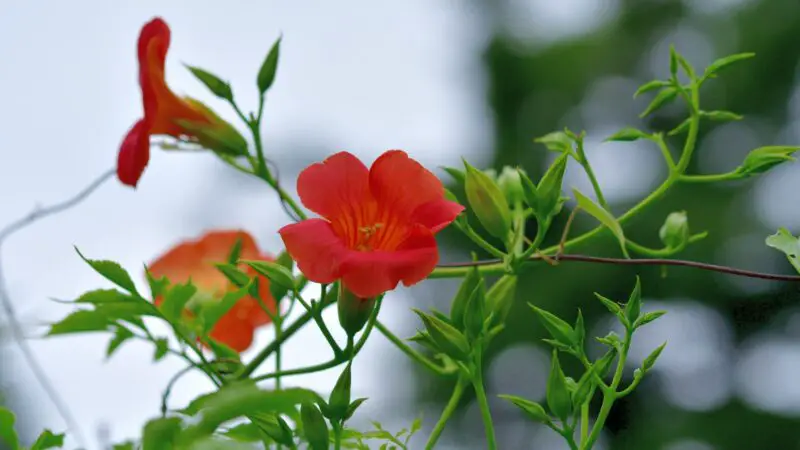
Also known as Campsis or Trumpet Creeper, this deciduous vine is well-suited for zones 4 to 9. The trumpet-shaped flowers, typically in shades of orange or red, attract hummingbirds with their nectar-rich blossoms. With its rapid growth and ability to cover unsightly structures, trumpet vines are a popular choice for gardeners seeking quick coverage.
Plant trumpet vine in full sun with well-draining soil. Be mindful of its robust growth and provide sturdy support, as it can become heavy. Regular pruning helps control its exuberance and promotes a more compact and manageable form.
8). Jasmine (Zones 7-10)
Jasmine, renowned for its sweet fragrance, is a fast-growing vine that thrives in zones 7 to 10. The star-shaped, white flowers emit a captivating scent that fills the air, making it a favorite for gardens and outdoor spaces. Beyond its aromatic blooms, jasmine vines also provide lush greenery, creating a visually appealing backdrop.
Plant jasmine in well-drained soil and ensure it receives ample sunlight. While it can tolerate partial shade, full sun encourages more robust flowering. Regular pruning after the blooming season helps maintain its shape and promotes healthy growth.
9). Moonflower (Annual, All Zones)
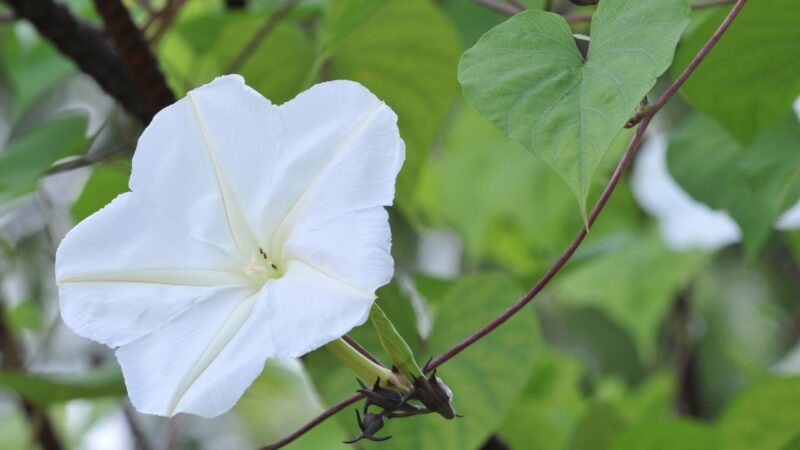
If you’re seeking a fast-growing, night-blooming vine, the Moonflower is an enchanting choice. While technically an annual, it rapidly covers trellises and arbors, producing large, fragrant, white blossoms that unfurl in the evening. This nocturnal beauty adds a touch of magic to moonlit gardens.
Plant moonflower seeds in well-drained soil and provide support for its climbing habit. Due to its rapid growth, it quickly establishes a lush and green cover. Since it’s an annual, consider collecting seeds for the next planting season to perpetuate its presence in your garden.
10). Crossvine (Zones 6-9)

The Crossvine, or Bignonia capreolata, is a vigorous and fast-growing vine that thrives in zones 6 to 9. Known for its trumpet-shaped flowers that bloom in vibrant shades of orange and red, this native American vine is an excellent choice for covering fences and arbors. Its name is derived from the cross-shaped pattern seen when the stem is cut horizontally.
Plant Crossvine in full sun to partial shade, and provide well-drained soil. Once established, it exhibits drought tolerance, making it suitable for various climates. Regular pruning helps maintain a tidy appearance and encourages more prolific flowering.
11). Black-Eyed Susan Vine (Annual, All Zones)

The Black-Eyed Susan Vine (Thunbergia alata) is a charming annual vine that quickly covers trellises and vertical spaces. While it’s an annual, its rapid growth and profusion of cheerful, tubular flowers in shades of yellow, orange, and white make it a popular choice for summer gardens across all zones.
Plant Black-Eyed Susan Vine in well-drained soil and provide support for its climbing habit. This vine is perfect for adding a burst of color to fences, balconies, and containers. Regular deadheading encourages continuous blooming throughout the growing season.
12). Chocolate Vine (Zones 5-9)

Akebia quinata, commonly known as the Chocolate Vine, is a deciduous and fast-growing vine that thrives in zones 5 to 9. Named for the rich chocolate-like scent of its flowers, this vine produces unique, maroon-colored blooms in spring. The foliage is equally attractive, providing dense coverage with palmate leaves.
Plant Chocolate Vine in well-draining soil, and it will tolerate both full sun and partial shade. This low-maintenance vine is an excellent choice for pergolas and fences, creating a lush and aromatic haven in your garden.
13). Silver Lace Vine (Zones 4-9)
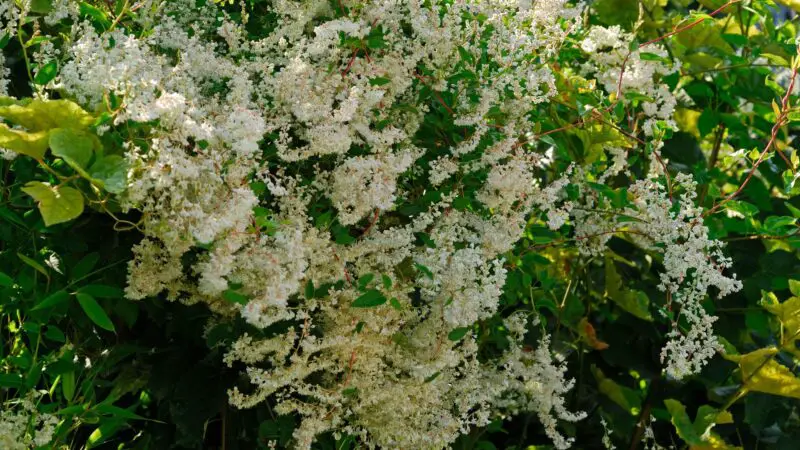
For gardeners in zones 4 to 9 looking for a delicate and fast-growing vine, the Silver Lace Vine (Polygonum aubertii) is an ideal choice. Also known as Fallopia baldschuanica, this deciduous vine boasts sprays of small, fragrant white flowers that resemble lace. It’s a reliable and hardy climber that adds a touch of elegance to any garden.
Plant Silver Lace Vine in well-draining soil and provide support for its climbing habit. Full sun to partial shade suits this vine, and it tolerates a variety of soil types. Regular pruning helps control its growth and promotes a neat appearance.
14). Coral Honeysuckle (Lonicera sempervirens) – Zones 4-9:
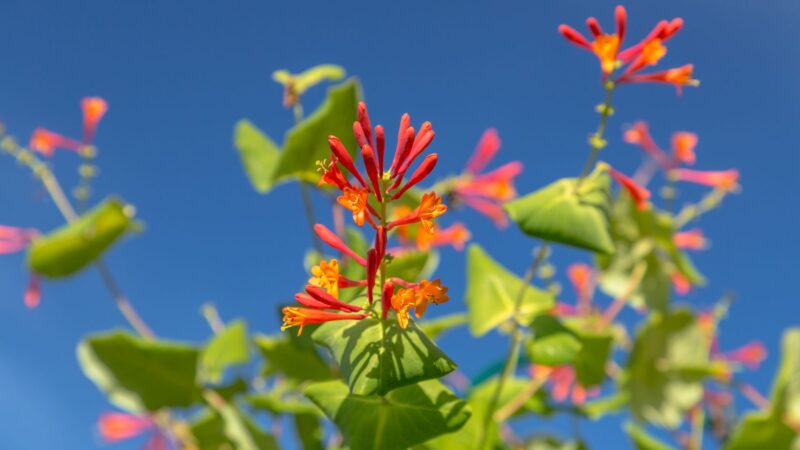
Also known as Trumpet Honeysuckle, Coral Honeysuckle is a native vine to North America. This fast-growing and twining vine produces clusters of tubular, coral-colored flowers that attract hummingbirds and butterflies. It’s a great choice for gardeners in zones 4 to 9, providing a burst of color in spring and early summer.
Plant Coral Honeysuckle in well-drained soil and provide support for climbing. It thrives in full sun to partial shade. Pruning after flowering helps maintain a tidy shape and encourages more blooms.
15). Mandevilla (Zones 9-11)
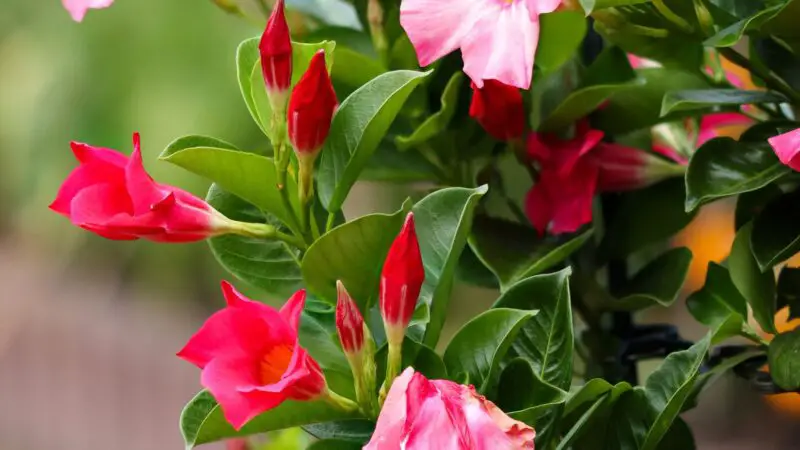
17 Fast-Growing Flowering Vines
If you’re seeking a tropical touch to your garden, Mandevilla is an excellent choice. This fast-growing vine is well-suited for zones 9 to 11, where it thrives in warm and humid conditions. Mandevilla features large, trumpet-shaped flowers in shades of pink, red, and white, adding a touch of exotic beauty.
Plant Mandevilla in well-drained soil with access to full sun. Provide support for its climbing habit, and consider growing it in containers for a stunning patio display. Regular pruning helps control its growth and encourages branching.
16). Silver Falls Dichondra (Annual, All Zones)
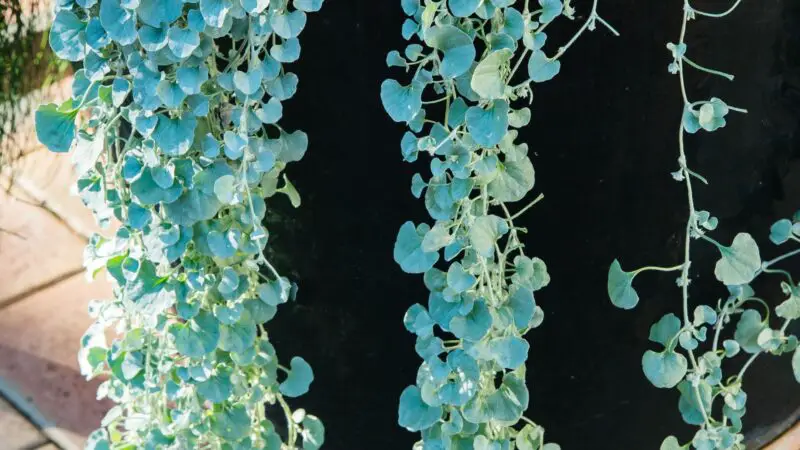
While not a traditional flowering vine, Silver Falls Dichondra is a fast-growing trailing plant that adds cascading silver foliage to hanging baskets and containers. It is often used as a ground cover or as a “spiller” in mixed container gardens. Though an annual, it rapidly provides a lush and elegant appearance throughout the growing season.
Plant Silver Falls Dichondra in well-drained soil and provide ample sunlight for optimal growth. Its trailing habit makes it a perfect addition to containers, hanging baskets, or as a ground cover. Regular pruning can help maintain a neat appearance.
17). Virginia Creeper (Parthenocissus quinquefolia) – Zones 3-9
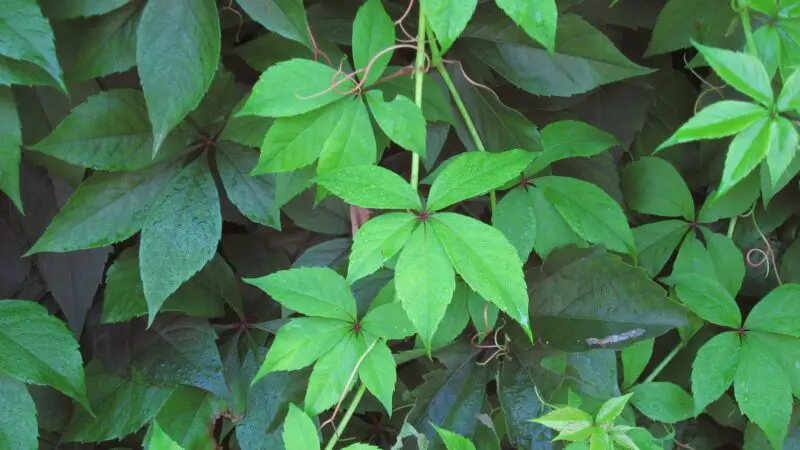
For gardeners in a wide range of hardiness zones (3-9), Virginia Creeper offers a fast-growing and adaptable vine option. With its palmate leaves that turn vibrant shades of red in the fall, this deciduous vine provides seasonal interest beyond its greenery. While it doesn’t produce showy flowers, its foliage and ability to quickly cover structures make it a popular choice.
Plant Virginia Creeper in well-drained soil and provide support for climbing. This vine tolerates a variety of light conditions, from full sun to partial shade. Regular pruning can help manage its growth and prevent it from becoming invasive.
Wrap Up
Now that we have covered all there is to know about fast-growing flowering vines, you should be able to choose from a wide variety of options depending on your hardiness zone and gardening style.
From the native charm of Coral Honeysuckle to the tropical allure of Mandevilla, each vine adds its own special qualities to enhance your outdoor space.
Whether you are going for bright pops of color, lush greenery, or a combination of both, these fast-growing vines will definitely turn your garden into a haven of natural beauty. Happy gardening!
Here’s a set of frequently asked questions related to fast-growing flowering vines:
Q1: What are the benefits of planting fast-growing flowering vines in the garden?
A1: Fast-growing flowering vines offer numerous benefits for gardeners. They quickly provide coverage, adding privacy and transforming unsightly structures. These vines also contribute to the overall beauty of the garden, attracting pollinators and creating lush greenery.
Q2: How do I choose the right flowering vine for my hardiness zone?
A2: Consider your USDA hardiness zone, which determines the climate of your region. Different vines thrive in specific zones, so choose varieties that are well-suited to your climate. Additionally, factors such as soil type, sunlight, and available space should influence your decision.
Q3: What are some general tips for growing fast-growing flowering vines?
A3: Provide well-draining soil, adequate support for climbing, and the appropriate amount of sunlight based on the vine’s requirements. Regular pruning helps manage growth, encourage flowering, and maintain an attractive shape.
Q4: Are there any invasive concerns with fast-growing vines?
A4: Some fast-growing vines, like Wisteria or Virginia Creeper, can become invasive if not properly managed. Regular pruning and monitoring are essential to prevent these plants from spreading uncontrollably.
Q5: Can fast-growing vines be grown in containers?
A5: Yes, many fast-growing vines, such as Mandevilla or Black-Eyed Susan Vine, can thrive in containers. Ensure the container has proper drainage, use high-quality potting mix, and provide support for climbing. Container gardening allows flexibility in placing vines on patios, balconies, or other confined spaces.
Q6: How can I encourage more blooms on my flowering vine?
A6: Regular pruning is key to encouraging more blooms. Trim back dead or spent flowers to promote new growth. Additionally, providing the right amount of sunlight and proper nutrients supports healthy flowering.
Q7: Are there any low-maintenance fast-growing vines?
A7: Yes, several fast-growing vines, like Virginia Creeper or Silver Lace Vine, are relatively low-maintenance. They adapt well to different conditions and require minimal care once established.
Q8: Can I grow flowering vines indoors?
A8: While some vines can be grown indoors, many, especially the fast-growing varieties, are better suited for outdoor cultivation. Indoor success depends on factors like sufficient sunlight, humidity, and space.
Q9: How do I control the growth of fast-growing vines?
A9: Regular pruning is essential for controlling the growth of fast-growing vines. Trim back excessive growth, remove dead or damaged branches, and shape the plant according to your preferences. This helps maintain a tidy appearance and prevents overgrowth.
Q10: Can I grow annual vines from seeds?
A10: Yes, many annual vines, like Morning Glory or Black-Eyed Susan Vine, can be grown from seeds. Follow the seed packet instructions for planting depth, soil type, and sunlight requirements. Annuals are a great way to add quick, seasonal color to your garden.

